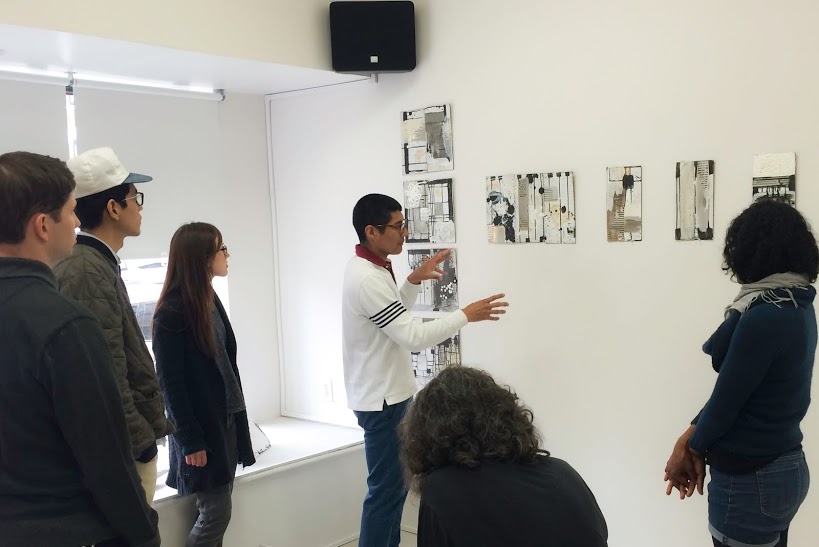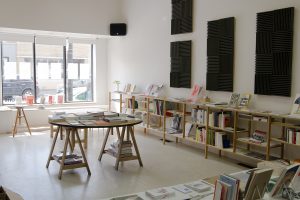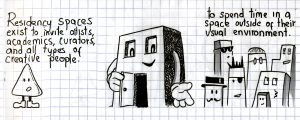In On Criticism, Noel Carroll devises a system of hierarchical relations that are used to define, inspect, and evaluate art objects in the manner of critique. Carroll attempts to excavate the foundations of any critical practice, whether theory driven or otherwise. In the book, Carroll makes an important distinction between criticism and the philosophy of art—a critical theory (such as post-structuralist theory) “tells you how to interpret an artwork,” whereas philosophy probes “the nature of and constraints upon anything that we should be persuaded is an authentic specimen of interpretation, including ones that take their meaning from the marching orders from theories.” According to this dynamic, philosophy sets the parameters of what may be considered art, but the primary task of criticism is to discover value.
Based on this premise, we invited local artists to New Projects to discuss value in artwork. A multi-disciplinary space, we invited creatives with different histories, aesthetics, and ideological framings to comment on art criticism in the context of a critique. As a group, we challenged the objective evaluation of art and searched for our own understanding of value. Rather than rehashing a summary of the critic’s philosophy, we developed operational definitions of problematic ideas such as: value & evaluation, criticism, art, power, and monetary exchange. The conversation is an experimental dialectic that should challenge your own set of values and assumptions and make you question why? Why are things this way? Am I aware that my universe of experiential relations informs my judgment of art and its apparent value? Should artist in a creative community discover value in artworks based on judgments that are grounded in reason?
We held our conversation on art criticism and value at New Projects on Sunday, May 10. Our focal point was a collection of works by artist Lynn Basa, including Interrogations, Standing Painting, Bundle, and Tilted Painting. The conversation was moderated and contextualized by Rudi, Grace Needlman, and myself, and the other participants were Lynn Basa, Alyx Christenson, Meheriet Fesseha, Alan Medina, Gaelin Monkman-Kotz, and Boris Ostrerov.
Critique

Lynn Basa
I started studying ceramics when I was in the 7th grade and got my undergraduate degree in that medium. I started doing fiber seriously for a long time, but gave it up about 15 years ago to do painting. I like the direct process of painting and find that I can express myself and say the same things I was trying to say doing imagery with fiber and the texture of ceramics. This collection was made in Judith Geichman’s MFA class at SAIC. These are two-sided paintings. I would like for everyone to get up and look at them and turn them around, that is part of the experience of them.
Alyx Christenson
They feel very spatial, the cardboard is an infrastructure you are exposing. The interrogation seem like an underlying layer that exists regardless of what is added to it. I find this one the most interesting. The use of cardboard as a space or an object that can read as a painting is really nice. I think the cardboard itself gets abstracted and allow you to enter spatially.
Grace Needlman
I am interested in your Interrogations, and the desire for discovery. I love the Bundle because whenever we put it down the white surface is always face up. There is something about turning over a rock to see what is underneath. The preciousness of it is very innocent, and childlike. You presented a very austere white square, but you can pick it up and flip around to reveal all sorts of textures and discoveries that I get to make. It’s interesting to take a material that does initially make us roll our eyes, everybody makes prototypes out of cardboard or has some relation to the material. Is there something that we don’t yet know about cardboard? Maybe it does come in the actions you ask us to take, to rediscover what it feel like to put our fingers in these little holes of cardboard. This feels really transgressive. It feel very urgent, to take something that is boring and make it exciting again.
Rudi
These paintings read as episodes, what happens in the background always takes you back to cardboard, which can be distracting to the viewer. I think of cardboard as a leftover material. I am interested in seeing the transformation of the commonplace, maybe if it was bigger? I want to get lost in the form, but I always went back to the materiality of the cardboard. I feel like the sculptures enter the area these paintings are trying to investigate.
Gaelin Monkman-Kotz
I feel the cardboard is interesting because you are playing with surface, and the illusory qualities of surface. At some points the cardboard is exposed, and I liked the two sided paintings along with the Interrogations, I feel like they are all engaging in conversation.
Alan Medina
I think your lines in the paintings are more interesting that the manufactured lines of the cardboard. I also think in these areas where the cardboard is hidden, something more interesting happens with an invisible ridge forming behind it all.
Oscar Solis
I wanted to discuss your choice of palette. From the sculptural objects to the interrogations, it is all painted in black and white with some gradations of gray and tan. To me, it looks like you are in a binary between precious/worthless, here/there, painting/object. You play with a false dichotomy that doesn’t really exist. You have really nice moments of gold leaf & tea stains, activated by the brown cardboard. Explore that palette. There are no pure whites or blacks, and the grays are a little flat. Make the gradations more obvious to show the balance or false balance that people already associate with value/no value, spacial/temporal work.
Boris Ostrerov
I think people have trouble with the cardboard because you are talking about cardboard in terms of what It looks like and how it’s used as a material, but people read it as the meaning. It’s not a neutral thing, you did not use a standard canvas on stretcher bars to paint on, how are you addressing or giving it a new meaning? Maybe you just disregard that it is cardboard and do your own thing. In reference to your Interrogations, I’m interested in why you restricted yourself to that small size. I think it would work better bigger, the scale is too intimate. What’s the difference for you between painting and sculptor? These are interesting objects to look at, but traditionally painting is what you look into. If this was two feet, it might be able to engulf me. The marks, the scale, the medium can only have meaning in relation to what you trying to do. You can only learn those relations through working. You are asking us to judge it, but based on what criteria?
Conversation
Can we identify shared value through critique?
Grace Needlman
There is a trend in the art community against judging other people’s work as good or bad. Carroll describes several arguments against evaluation such as the impossibility of reaching an objective, reasoned understanding of an artwork. Is reaching truth through evaluative critique impossible? If it is, does that negate the importance of critique?
Alan Medina
Even if a critic reaches his own absolute truth about the artwork, that’s his own interpretation. Still, it influences the people who read it. He is defining an artwork for people. I might disagree with that. I might read it differently on a personal level.
Oscar Solis

Carroll was trying to come up with a systematic approach that we can all use to engage with an artwork. In the end, we are all going to have our own personal interpretations, but Carroll is providing a groundwork we can all relate to. We all understand what black means, we all understand what white means. We all understand what a painting is. It provides an atmosphere for a discussion. He is providing his experience, his understanding of value in an artwork. It’s only a suggestion. You should go see it for yourself and make your own judgment.
Lynn Basa
There is value created by manufactured consent. Look! Here’s Sterling Ruby. He’s important. His work costs lots of money because we’ve decided that he’s in the canon of artists whose work costs lots of money. The artist who is born innocent of all this can walk up to the Mona Lisa and say, “That really sucks.” Instead, we believe “I’m in the presence of the greatest painting in the world, because I’ve been told I’m in the presence of the greatest painting in the world.”
Grace Needlman
We can come to intersubjective agreements through discussion, through voicing our own experiences. If we’re too scared to voice our judgment, we’re never going to reach any collective meaning. What’s valuable are the intersubjective truths we find through conversation.
Meheriet Fesseha
I think the purpose of the critique is to help the artist get better at their craft. Did the artist meet their goal? It’s not necessarily for the consumer of art. I think consuming is a form of taking and not giving back.
Lynn Basa
The question is: what is the artist trying to do? did they do it? was it worth doing?But i’m interested in your separation of artists from consumers. We are all consumers.
WHAT MAKES AN ARTWORK VALUABLE?

Rudi
Developing a taste in something, is that a kind of consumption? If you taste something you like, you keep on tasting it. If you identify a taste in art, you keep going back to the same artist or form of art.
Gaelin Monkman-Kotz
It seems like criticism is the opposite of consumption. The artworks’ energy is renewed in some way. Artwork that I consider valuable is able to give an expression to something that I haven’t been able to express or that I didn’t have words for. I think valuable literature gives language meaning, it touches on something I didn’t have words for before.
Meheriet Fesseha
I think the experience of art comes before value and meaning. Meaning is based on your relationship to an art object. Value comes from how impactful the experience of that object was.
Rudi
I want to be challenged by artwork. I want to be pushed. I want to look at artwork that makes me challenge myself. I want to unravel why I was left with these questions
Grace Needlman
The things that are valuable in my life are the things that give me agency. They expand what it is possible for me to think and do. They expand what is possible in making art.
Boris Ostrerov
If an artwork is valuable to you, that means it’s valuable to other people. Wittgenstein said “there’s no such thing as a subjective language.” If you understood that artwork, that means other people did to.
Oscar Solis
“The limits of my language define the limits of my world”
Lynn Basa
We do consume things but they come out in another form of energy. My time has value. I don’t have time to follow all of these ideas, so what do I pursue? I need help deciding. But artists know it is up to the individual to make that evaluative decision for themselves. Otherwise you are making art for somebody else.
 Pilsen based writer Oscar Solis is co-director of a multidisciplinary art space New Projects. He has recently enrolled in The School of the Art Institutes Master’s in Visual / Critical Studies program. When he is not facilitating an arts program at Eli Whitney Elementary School, he is eating spicy tamales at Dia de los Tamales.
Pilsen based writer Oscar Solis is co-director of a multidisciplinary art space New Projects. He has recently enrolled in The School of the Art Institutes Master’s in Visual / Critical Studies program. When he is not facilitating an arts program at Eli Whitney Elementary School, he is eating spicy tamales at Dia de los Tamales.



